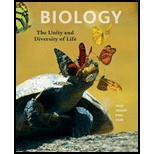
Concept explainers
Which is not a
a. adenine
b. guanine
c. glutamine
d. thymine
e. cytosine
f. All are in DNA.
Concept introduction: Nucleotides are building blocks of DNA and RNA. DNA has four nucleotides, namely adenine and guanine (which are purines), and thymine and cytosine (which are pyrimidines).
Answer to Problem 1SQ
Correct answer: Glutamine is not a nucleotide base in the DNA. Therefore, option c. is correct.
Explanation of Solution
Reasons for the correct statement:
Glutamine is a basic amino acid. DNA is made of purines and pyrimidines that are collectively called as nucleotides. Glutamine is neither a purine nor a pyrimidine.
Option c. is given as “glutamine”
As glutamine is an amino acid and not a nucleotide base, option c. is correct.
Reasons for the incorrect statements:
Option a. is given as “adenine”.
Adenine is a purine and a nucleotide base in DNA. Therefore, option a. is incorrect.
Option b. is given as “guanine”.
Guanine is a purine and is a nucleotide base in DNA. Therefore, option b. is incorrect.
Option d. is given as “thymine”.
Thymine is a pyrimidine and is a nucleotide base in DNA. Therefore, option d. is incorrect.
Option e. is given as “cytosine”.
Cytosine is a pyrimidine and is a nucleotide base in DNA. Therefore, option e. is incorrect.
Option f. is given as “All are in DNA”.
Adenine, guanine, cytosine, and thymine are present in DNA, and glutamine is absent in DNA. Therefore, option f. is incorrect.
Hence, options a., b., d., e., and f. are incorrect.
Want to see more full solutions like this?
Chapter 8 Solutions
Biology: The Unity and Diversity of Life (MindTap Course List)
- Plating 50 microliters of a sample diluted by a factor of 10-6 produced 91 colonies. What was the originalcell density (CFU/ml) in the sample?arrow_forwardEvery tutor here has got this wrong, don't copy off them.arrow_forwardSuppose that the population from question #1 (data is in table below) is experiencing inbreeding depression (F=.25) (and no longer experiencing natural selection). Calculate the new expected genotype frequencies (f) in this population after one round of inbreeding. Please round to 3 decimal places. Genotype Adh Adh Number of Flies 595 Adh Adh 310 Adhs Adhs 95 Total 1000 fladh Adh- flAdn Adh fAdhs Adharrow_forward
- Which of the following best describes why it is difficult to develop antiviral drugs? Explain why. A. antiviral drugs are very difficult to develop andhave no side effects B. viruses are difficult to target because they usethe host cell’s enzymes and ribosomes tometabolize and replicate C. viruses are too small to be targeted by drugs D. viral infections usually clear up on their ownwith no problemsarrow_forwardThis question has 3 parts (A, B, & C), and is under the subject of Nutrition. Thank you!arrow_forwardThey got this question wrong the 2 previous times I uploaded it here, please make sure it's correvct this time.arrow_forward
- This question has multiple parts (A, B & C), and under the subject of Nutrition. Thank you!arrow_forwardCalculate the CFU/ml of a urine sample if 138 E. coli colonies were counted on a Nutrient Agar Plate when0.5 mls were plated on the NA plate from a 10-9 dilution tube. You must highlight and express your answerin scientific notatioarrow_forwardDon't copy off the other answer if there is anyarrow_forward

 Concepts of BiologyBiologyISBN:9781938168116Author:Samantha Fowler, Rebecca Roush, James WisePublisher:OpenStax College
Concepts of BiologyBiologyISBN:9781938168116Author:Samantha Fowler, Rebecca Roush, James WisePublisher:OpenStax College Human Biology (MindTap Course List)BiologyISBN:9781305112100Author:Cecie Starr, Beverly McMillanPublisher:Cengage Learning
Human Biology (MindTap Course List)BiologyISBN:9781305112100Author:Cecie Starr, Beverly McMillanPublisher:Cengage Learning Biology (MindTap Course List)BiologyISBN:9781337392938Author:Eldra Solomon, Charles Martin, Diana W. Martin, Linda R. BergPublisher:Cengage LearningEssentials of Pharmacology for Health ProfessionsNursingISBN:9781305441620Author:WOODROWPublisher:Cengage
Biology (MindTap Course List)BiologyISBN:9781337392938Author:Eldra Solomon, Charles Martin, Diana W. Martin, Linda R. BergPublisher:Cengage LearningEssentials of Pharmacology for Health ProfessionsNursingISBN:9781305441620Author:WOODROWPublisher:Cengage Human Heredity: Principles and Issues (MindTap Co...BiologyISBN:9781305251052Author:Michael CummingsPublisher:Cengage Learning
Human Heredity: Principles and Issues (MindTap Co...BiologyISBN:9781305251052Author:Michael CummingsPublisher:Cengage Learning





